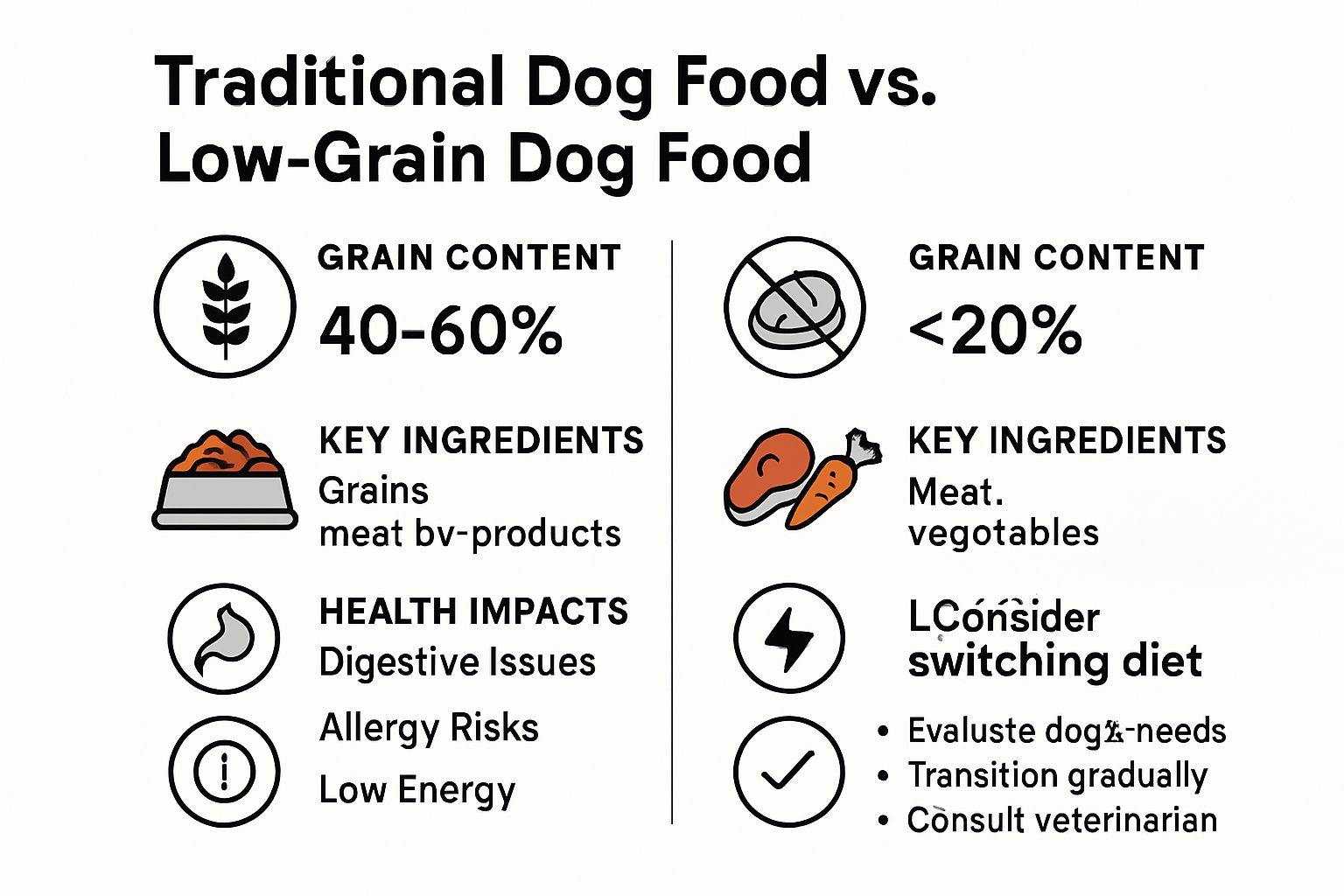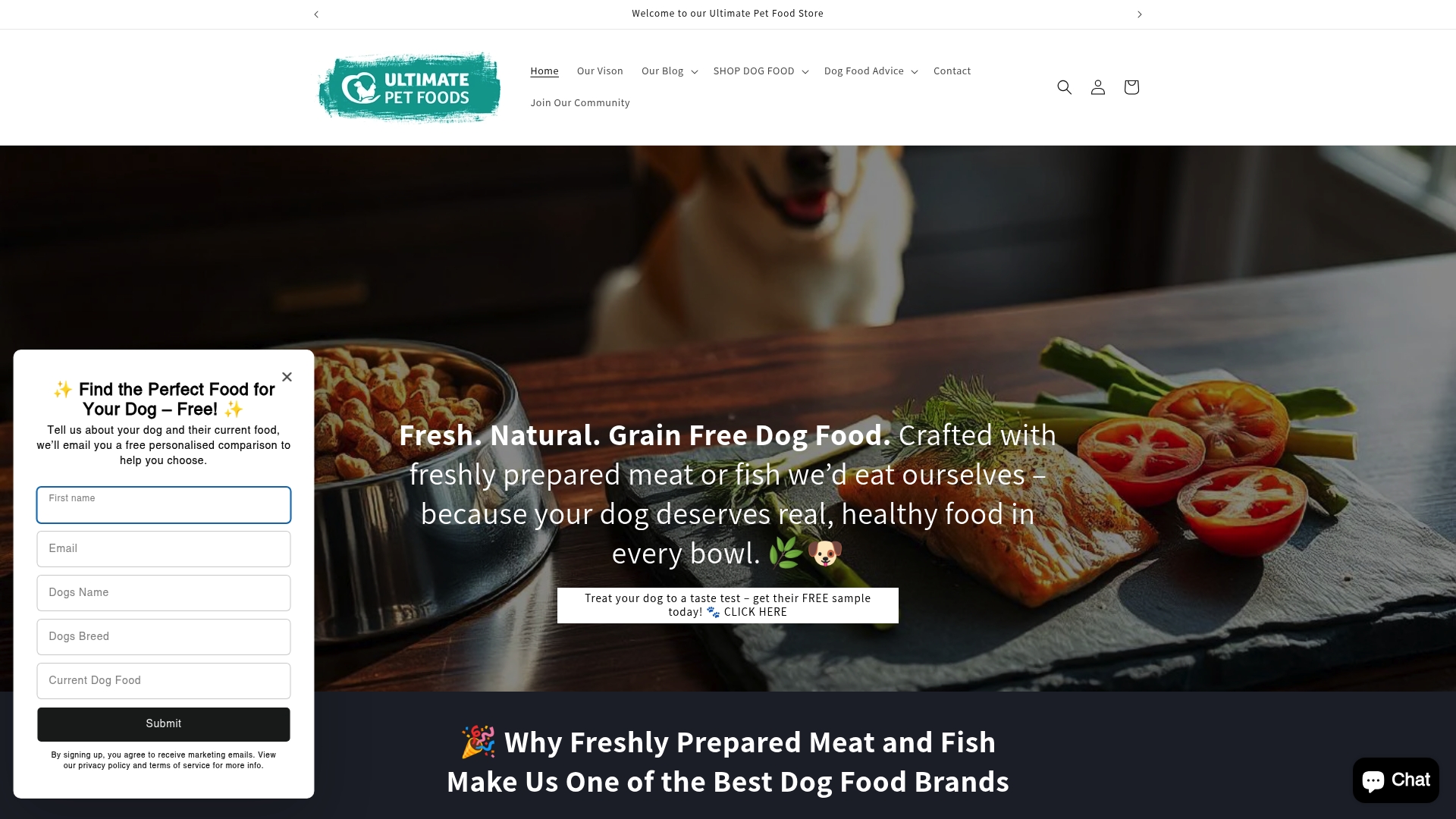
Understanding Low Grain Dog Food and Its Benefits
Share
Low grain dog food is showing up on more shelves as owners look for nutrition that matches their dog’s real needs. Here is something that stands out. Over 60 percent of traditional dog foods use high levels of grains as cheap fillers, but low grain formulas cut those way down. This switch does more than you think. Turns out, the biggest benefit is not just in what they remove but in what they add, with high-quality proteins that can actually improve your dog’s energy, digestion, and overall health.
Table of Contents
- What Is Low Grain Dog Food And How Is It Different?
- Why Choosing Low Grain Dog Food Matters For Canine Health
- How Low Grain Diets Support Dogs With Food Sensitivities
- Key Nutritional Concepts In Low Grain Dog Food Formulations
- Real-World Considerations: Choosing The Right Low Grain Dog Food
Quick Summary
| Takeaway | Explanation |
|---|---|
| Low grain food supports digestive health. | Reducing grain content may alleviate digestive sensitivities and improve nutrient absorption for sensitive dogs. |
| Choose high-quality protein sources. | Prioritize dog foods with whole meats and nutrient-dense proteins instead of grain-based fillers. |
| Consult a vet for tailored nutrition. | Individual health assessments are crucial to determine the best dietary strategy for your dog’s unique needs. |
| Monitor your dog’s health regularly. | Keep track of weight, energy levels, and overall condition to validate the effectiveness of the low grain diet. |
| Evaluate ingredient quality carefully. | A close look at ingredient lists ensures your dog is receiving a comprehensive and nutritionally balanced diet. |
What is Low Grain Dog Food and How is it Different?
Low grain dog food represents a strategic approach to canine nutrition that reduces grain content while maintaining balanced nutritional profiles. Unlike traditional dog food formulations that rely heavily on grains as primary ingredients, low grain options strategically modify grain proportions to support better digestibility and address potential dietary sensitivities.
To clarify the main nutritional differences between traditional and low grain dog foods, the following table compares their primary features, ingredients, and benefits side-by-side.
| Aspect | Traditional Dog Food | Low Grain Dog Food |
|---|---|---|
| Grain Content | High (wheat, corn, rice as fillers) | Reduced; minimal grains used |
| Primary Protein Source | Plant-based, some animal by-products | High-quality animal proteins |
| Carbohydrate Source | Mostly grains | Sweet potatoes, legumes, alternative carbs |
| Suitability for Sensitivities | May trigger digestive issues or allergies | Better for dogs with sensitivities |
| Nutrient Absorption | May be hindered by fillers | Enhanced due to fewer fillers and better ingredients |
| Digestibility | Potentially lower, more fillers | Improved due to alternative nutrient sources |
Understanding Grain Content in Dog Nutrition
Traditional dog foods often contain substantial amounts of grains like wheat, corn, and rice as primary filler ingredients. Low grain dog food, by contrast, minimizes these components, typically replacing them with alternative protein sources and nutrient-dense ingredients. According to research from the National Institutes of Health, these modifications can provide several nutritional advantages for dogs with specific health requirements.
Key characteristics of low grain dog food include:
- Reduced grain percentage compared to standard formulations
- Higher proportion of animal proteins
- Enhanced digestibility for sensitive dogs
- Potential reduction in inflammatory responses
Nutritional Composition and Benefits
Low grain dog food prioritizes high-quality protein sources and alternative carbohydrate ingredients. These formulations often incorporate ingredients like sweet potatoes, legumes, and meat-based proteins to replace traditional grain content. The goal is creating a more biologically appropriate diet that more closely mimics a dog’s natural ancestral eating patterns.

For pet owners seeking comprehensive nutrition information, our guide on digestive health provides additional insights into specialized dietary approaches for dogs with unique nutritional needs.
Why Choosing Low Grain Dog Food Matters for Canine Health
Choosing low grain dog food is not just a dietary trend but a strategic approach to supporting canine health and addressing specific nutritional challenges. The composition of a dog’s diet plays a critical role in their overall wellness, metabolism, and long-term health outcomes.
Addressing Canine Dietary Sensitivities
Many dogs experience digestive sensitivities and allergic reactions triggered by traditional grain-heavy diets. Low grain dog food provides an alternative that can help mitigate these issues by reducing potential inflammatory responses and minimizing common allergens. According to research from the Journal of Animal Science, diet composition significantly impacts a dog’s digestive health and nutrient absorption.
Key health considerations for low grain dog food include:
- Reduced risk of food-related allergic reactions
- Improved digestive system performance
- Better nutrient absorption
- Potential reduction in gastrointestinal inflammation
Nutritional Balance and Metabolic Health
Low grain dog food formulations focus on providing comprehensive nutrition through alternative protein sources and nutrient-dense ingredients. By prioritizing high-quality proteins and complex carbohydrates, these diets support optimal metabolic function and help maintain stable energy levels. For pet owners interested in specialized nutrition strategies, our guide to salmon-based nutrition offers additional insights into targeted dietary approaches for dogs with unique health requirements.
Understanding individual dog needs remains crucial. While low grain diets offer numerous potential benefits, consulting with veterinary professionals ensures the most appropriate nutritional strategy for each dog’s specific health profile and life stage.
How Low Grain Diets Support Dogs with Food Sensitivities
Food sensitivities in dogs represent a complex nutritional challenge that can significantly impact their overall health and quality of life. Low grain diets offer a strategic approach to managing these sensitivities by reducing potential dietary triggers and supporting more balanced nutritional absorption.
Understanding Canine Food Sensitivity Mechanisms
Food sensitivities occur when a dog’s immune system responds negatively to specific dietary proteins or ingredients. Traditional dog foods often contain multiple potential allergens, including grains like wheat, corn, and soy. According to research from the National Institutes of Health, eliminating or reducing these ingredients can help minimize inflammatory responses and digestive complications.
Common signs of food sensitivities in dogs include:
- Persistent skin irritations
- Chronic digestive issues
- Recurrent ear infections
- Unexplained gastrointestinal discomfort
- Inconsistent energy levels
Below is a table summarizing the most common signs of food sensitivities in dogs, as mentioned in the article, to help you identify if your own pet may benefit from a dietary change such as low grain food.
| Sign of Sensitivity | Description |
|---|---|
| Persistent skin irritations | Ongoing itchiness, redness, or rashes |
| Chronic digestive issues | Frequent diarrhea, vomiting, or loose stools |
| Recurrent ear infections | Regular ear problems not caused by injury |
| Unexplained GI discomfort | Signs of bloating, abdominal pain, discomfort |
| Inconsistent energy levels | Fluctuating stamina or sudden lethargy |

Nutritional Strategies for Sensitive Dogs
Low grain diets provide an alternative nutritional pathway by replacing traditional grain ingredients with high-quality protein sources and easily digestible carbohydrates. These formulations focus on supporting digestive health while minimizing potential inflammatory triggers. For pet owners seeking deeper insights into managing canine digestive challenges, our comprehensive digestive care guide offers valuable strategies for supporting dogs with sensitive systems.
Individual dog responses vary, making personalized nutrition consultation with veterinary professionals essential. A targeted approach considering the dog’s specific health profile, breed characteristics, and identified sensitivities ensures the most effective dietary management strategy.
Key Nutritional Concepts in Low Grain Dog Food Formulations
Low grain dog food formulations represent a sophisticated approach to canine nutrition, focusing on balanced macronutrient profiles and strategic ingredient selection. Understanding the fundamental nutritional principles behind these diets helps pet owners make informed choices about their dog’s dietary needs.
Protein Quality and Composition
Protein serves as the cornerstone of low grain dog food formulations. These diets prioritize high-quality animal proteins as primary ingredients, replacing traditional grain-based fillers with nutrient-dense protein sources. According to research from the National Institutes of Health, alternative carbohydrate sources can provide essential energy and fiber while maintaining nutritional diversity.
Key protein considerations in low grain dog food include:
- Sourcing from whole meat or meat meals
- Ensuring complete amino acid profiles
- Prioritizing digestibility and bioavailability
- Matching protein levels to dog’s life stage and activity level
Carbohydrate and Micronutrient Balance
Low grain diets carefully select alternative carbohydrate sources to provide essential energy and nutritional support. Sweet potatoes, legumes, and other complex carbohydrates replace traditional grains, offering sustained energy and additional micronutrients. For dog owners seeking deeper insights into nutritional labeling, our comprehensive guide to understanding dog food labels provides valuable information about interpreting nutritional content.
The goal of low grain formulations is creating a nutritionally complete diet that supports optimal canine health through carefully balanced macronutrients and bioavailable ingredients. Each formulation considers breed, age, size, and individual metabolic requirements to ensure comprehensive nutritional support.
Real-World Considerations: Choosing the Right Low Grain Dog Food
Selecting the appropriate low grain dog food requires careful evaluation beyond marketing claims. Pet owners must consider multiple factors to ensure they are providing a nutritionally comprehensive diet that meets their dog’s unique physiological requirements.
Individual Dog Health Assessment
Every dog possesses distinct nutritional needs influenced by age, breed, activity level, and existing health conditions. According to research from the Journal of Animal Science, diet selection should not follow a universal approach but instead be tailored to individual canine characteristics. Veterinary consultation becomes crucial in determining whether a low grain diet represents the most appropriate nutritional strategy.
Key factors to evaluate before selecting a low grain diet include:
- Current weight and body condition
- Breed-specific metabolic requirements
- Existing health challenges or allergies
- Activity level and energy expenditure
- Current age and life stage
Nutritional Comprehensiveness and Quality
Low grain dog foods must provide complete nutritional profiles despite reduced grain content. This requires careful ingredient selection and balanced macronutrient composition. Pet owners should scrutinize ingredient lists, prioritizing whole protein sources and nutrient-dense alternatives to traditional grains. For those seeking nuanced insights into dietary management, our comprehensive digestive care guide offers advanced nutritional strategies.
Successful low grain diet implementation demands ongoing monitoring. Regular veterinary check-ups, weight assessments, and observing your dog’s energy levels, coat condition, and overall vitality will help validate the diet’s effectiveness and allow for necessary adjustments.
Ready to Transform Your Dog’s Nutrition with Premium Low Grain Options?
If your dog struggles with food sensitivities, digestive issues, or inconsistent energy, you know how hard it can be to find the right nutrition. This article highlighted the benefits of low grain formulations—fewer inflammatory triggers, high-quality proteins, and specially balanced recipes for all breeds. Take control of your dog’s health and discover formulas created to deliver exactly what your companion needs.
Explore our dedicated selection of grain free small breed dog food or browse salmon dog food for powerful hypoallergenic support.

Experience a real difference in your dog’s digestion, skin, and energy. Visit https://ultimatepetfoods.co.uk and shop now for science-backed nutrition designed for sensitive dogs. Give your pet the relief and vitality they deserve—start today for healthier meals with every bowl.
Frequently Asked Questions
What is low grain dog food?
Low grain dog food is a type of canine nutrition that reduces the amount of grains while maintaining balanced nutritional profiles, often replacing grains with alternative protein sources and nutrient-dense ingredients.
How does low grain dog food differ from traditional dog food?
Unlike traditional dog food that often relies heavily on grains like wheat and corn, low grain dog food minimizes these components, focusing instead on higher proportions of animal proteins and easily digestible carbohydrates.
What are the potential benefits of feeding my dog low grain dog food?
Feeding your dog low grain food can lead to improved digestive health, reduced risk of food-related allergies, better nutrient absorption, and enhanced metabolic functions due to its higher quality protein sources and lower grain content.
Is low grain dog food suitable for all dogs?
While low grain dog food can benefit many dogs, particularly those with dietary sensitivities or allergies, it’s important to consult with a veterinarian to ensure it meets your specific dog’s nutritional needs, age, and health conditions.
Recommended
- Success Story: How Ultimate+ Weight Control & Joint Care Helped Max Mo – Ultimate Pet Foods
- Bowl Missions – Ultimate Pet Foods
- Ultimate Digestive Care vs. Scrambles: Best Grain Free Dog Foods – Ultimate Pet Foods
- When Is a Dog Considered a Senior? Breed Size and Dog Year Conversions – Ultimate Pet Foods
